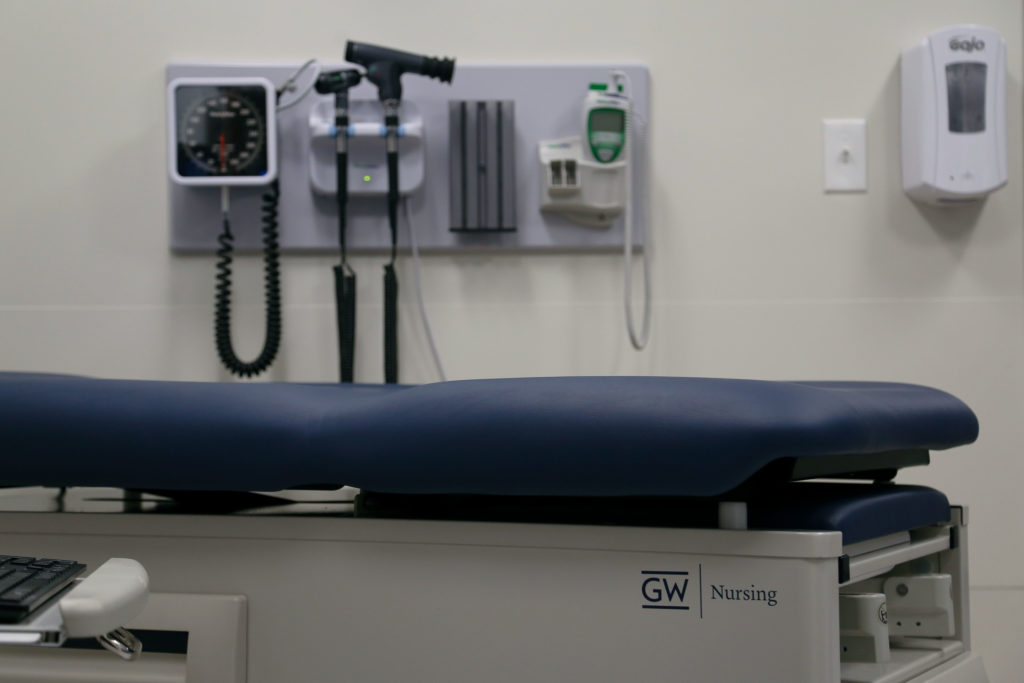On a Thursday afternoon, the first floor of the nursing school is abuzz with students chatting about homework and families visiting campus. But about a year ago, the now-bustling study area was quiet, absent of any signs of students or faculty.
While the Virginia Science and Technology Campus has struggled to find its identity in recent years, officials said a series of renovations on Innovation Hall – the nursing school’s flagship building – has promoted student engagement on the once deserted-feeling campus. The renovations, which will be completed by October, include a new student lounge and upgraded lab spaces, officials said.
University spokesman Tim Pierce said preparation for the renovations began in January and the demolition and construction of the first two floors of the nursing school began in February. He said the Student Success Center – a study space located on the first floor of Innovation Hall – is currently open, and the nursing school will be making additional improvements to the space this semester, like updating technology.
The space on the first floor now includes a lounge and open study space, with six group study rooms, he said.
“The Student Success Center was in direct response to student requests for additional study space, meeting rooms and other amenities,” Pierce said in an email. “There was also a need to create a workspace for an expanded student support staff.”
The first-floor study rooms vary in size and house two, four, six or eight students. Each room includes a whiteboard and markers, and Pierce said they were built with infrastructure to allow for added technology, like a television monitor that can be connected to a laptop.
Upstairs, there are more than 10 new clinical lab spaces where students can practice seeing live patient actors. The rooms also have a clock on the wall and double-sided glass, which allows faculty to observe their students during examinations without being present in the room.
Pierce said the new Observed Structured Clinical Examinations lab on the second floor of the building – including 12 private exam rooms and two acute care rooms – will be completed in time for nurse practitioner students’ upcoming campus visit this semester. He said there will also be a debriefing room, exam rooms used for testing, a control room, a break and changing room for live actor patients, a storage room and a support room.
Pierce said the newly renovated labs will provide students with a space to practice with standardized patients – actors that portray a clinical event in a simulation scenario. He said many of the standardized patients were hired by the nursing school in the past and are trained by the nursing school simulation team to portray a patient with a specific illness.
The renovations also included the addition of changing rooms and a shower space for standardized patients.
He said that previously, students in the Master of Science in Nursing program would have to travel to the Foggy Bottom Campus three times during their program to be evaluated using standardized patients at the medical school. Pierce said students can now be evaluated on the VSTC with the added space because of the renovations.
Pierce said future renovations will include enhancements to the school’s media studio – a space used to create video lectures for online classes.
Pierce declined to say how much the renovations cost.
Nursing experts said universities with nursing programs should continually update lab spaces because students need to practice with current medical equipment that is reflective of what is used in hospitals and clinics.
Katreena Merrill, the associate dean for undergraduate studies for the nursing school at Brigham Young University in Utah, said working with students in clinical lab spaces allows them to have exposure in a controlled setting to all types of illnesses and symptoms, whereas in an emergency room, students might only gain experience working with one type of patient, like a patient with a heart condition.
“By having lab experiences, you ensure that there’s a certain level of competency regardless of the variability in the clinical setting,” Merrill said. “They provide a realistic view of what it will be like so that students can be more prepared before they, say, start an IV on a real person.”
Margaret Miklancie, a retired professor of nursing at George Mason University, said the use of actors forces students to take practicing in a lab seriously because the student is working with a real person. She said the benefit to knowing the situation isn’t real is that a mistake won’t result in a less healthy patient like it would in an actual hospital or clinic.
“If people don’t know how to keep their cool under this pressure, they don’t belong yet in healthcare,” she said. “That’s where simulation really helps. It’s a reinforcement of learning.”
Helen Baker, an assistant clinical professor of nursing at Emory University, said that while standardized patients can be a preferred alternative to mannequins because they can verbally respond to the nursing student, they can be quite costly. Some standardized patients are paid about $40,000 each year on average.
“Standardized patients are good because you can know you’re getting exactly the same input to the students and it’s more realistic,” Baker said. “Mannequins, you can get them to talk but not as realistic as a real person.”
Dani Grace and Kathryn Sheehan contributed reporting.





